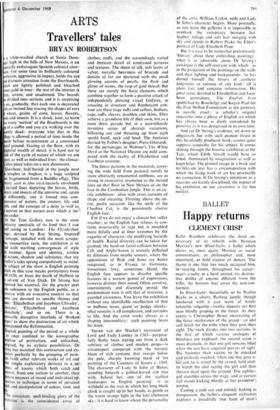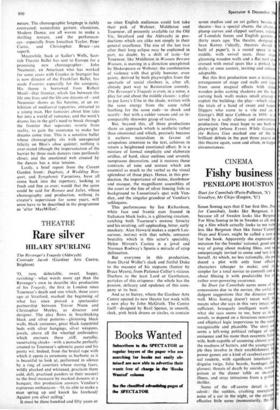BALLET
Happy returns
CLEMENT CRISP
Ballet Rambert celebrates the third an- niversary of its rebirth with Norman Morrice's new Blind-Sight, a ballet which shows us, once again, Morrice as social commentator, as philosopher and, most important, as bold creator of dances. The theme is one that has much occupied him, 1n-varying forms, throughout his career: man's cruelty as a herd animal, his destruc- tive dislike of anyone different from the tribe, the horrors that await the non-con- formist.
In Blind-Sight—beautifully set by Nadine Baylis in a silvery flashing jungle, though lumbered with a jazz score of barely tolerable vulgarity—twelve dancers are first seen blindly groping in the forest. At their centre is Christopher Bruce incarnating all they fierce intolerance of the group: an idol and fetish for the tribe when they gain their sight. The work divides into two sections, in the first of which various analogies of blindness are explored: the second scene is more dramatic, in that one girl remains blind when the rest have acquired powers of sight She becomes their victim, to be attacked and pitilessly mocked; when one boy goes to tier aid, he is seized by the crowd. held aloft to watch the idol raping the girl and then thrown dead upon the ground. The sightless girl stumbles across the stage, and at curtain fall stands kicking blindly at her protector's corpse.
Casting a cold eye and entirely lacking in compassion, the ballet's eloquent stylisation explores a dreadfully true facet of man's nature. The choreographic language is richly contrasted; naturalistic gesture, classicism, Modern Dance, are all woven to make a thrilling texture, and the performan- ces—especially from Jonathan Taylor, Peter Curtis, and Christopher Bruce—are superb.
Meanwhile, back at Sadler's Wells, Scot- tish Theatre Ballet has sent to Europe for a
promising new choreographer : John Netimeier, an American who has worked for some years with Cranko in Stuttgart but is now director of the Frankfurt Ballet, has made Frontier especially for the company. His theme is borrowed from Robert Musil—that frontier, which lies between the life one lives and the life one dreams of—and Neumeier shows us his heroine, at an ex- hibition of mediaeval tapestries, attracted to a young man. Her fantasies about him take her into a world of romance, and the work's drama lies in the girl's need to break through the frontier that separates reverie from reality, to gain the assurance to make her dreams come true. This is a sensitive ballet whose choreography sits with unexpected felicity on Bliss's oboe quintet; nothing is over-stated (though the impersonation of the barrier by three male dancers runs perilously close), and the emotional web created by the dances has a nice tension.
Lastly, a brief report from the Covent Garden front: Daphnis, A Wedding Bou- quet, and Symphonic Variations, have all come back into the repertory, looking as fresh and fine as ever; would that the same could be said for Romeo and Juliet, whose choreography and production, without its creator's supervision for some years, will soon have to be described in the programme as 'after • MacMillan'.







































 Previous page
Previous page